PinotFile: 9.31 October 11, 2013
|
David Adelsheim: A “Latecomer” Oregon Wine PioneerDavid Adelsheim likes to call himself a “latecomer” when talk turns to the pioneers of Oregon’s modern wine industry. Although Richard Sommer, David Lett, Charles Coury, Dick Erath and Dick Ponzi preceded him by a few years in planting vineyards and establishing wineries in Oregon, David not only founded an iconic Willamette Valley winery, he became a revered figure in Oregon wine after having participated as a respected spokesperson on practically every important issue facing the Oregon wine industry through the years. Despite his prestigious accomplishments, he remains modest and unassuming, with a charming sense of humor, all attributes that bring him much-deserved respect from his colleagues in Oregon. David was uniquely one of the name early Oregon wine pioneers that did not immigrate to Oregon. Although he moved to Portland from Kansas City with his family in 1954, he spent his formative years in Portland. After studying at University of California at Berkeley and in Germany, he received a bachelor’s degree in German literature from Portland State University. David became intrigued with artisan wines after a summer trip to Europe in 1969 with his spouse Ginny, who was a talented sculptor and artist. He soon immersed himself in the literature of winemaking, and dreamed of planting a vineyard in Oregon. In 1971, the Adelsheims had a chance meeting with Dick Erath and Bill Blosser at a May Day party. They directed the couple to seek out a south-facing slope with Jory soil appropriate for viticulture. Shortly after, they found an appropriate field in the Chehalem Mountains near Newberg, a site that was in a unproven viticultural area. In 1972, along with the help of friends and family, the Adelsheims first began the planting of 15 acres of Pinot Noir, Chardonnay, Pinot Gris and Riesling at what became Quarter Mile Lane Vineyard. The original Pinot Noir plantings in the 2.4-acre Block 1, planted in 1974, were obtained from Charles Coury and sold to David as Pommard clone. Over time, these Pinot Noir selections have been found to be more likely Martini clone or a mix of Martini and Pommard clone. David expanded his wine knowledge by working as a sommelier in Portland restaurants, including the popular L’Omellette for which David created the first wine list featuring an all-Oregon wine section. David also became close friends with David Lett of The Eyrie Vineyards, and gained valuable winemaking expertise through him. In 1974, he spent two months in Burgundy, studying at Beaune’s Lycée Viticole, looking at the availability of various cool climate grape varieties. In the Willamette Valley at the time, Pommard and Wädenswil clones dominated the Pinot Noir plantings, along with the so-called “Coury clone,” which has never been genealogically characterized. Adelsheim Vineyard released its first wines in 1978, a grand total of 1,300 cases, including a Pinot Noir from Quarter Mile Vineyard labeled “First Harvest,” tiny amounts of Chardonnay and Riesling from the same vineyard, and Semillon and Merlot from purchased grapes. The initial 6,000-square-foot winery was established in 1982 adjacent the Adelsheim’s home. A second property in the Chehalem Mountains, Calkins Lane, was acquired in 1988, and the 36.48-acre Calkins Lane Vineyard was established there, planted to Pinot Noir, Pinot Gris and Syrah. Also in 1988, 20 acres of a 60-acre site was leased across the road from the original estate vineyard, and planting began the following year in what became known as Bryan Creek Vineyard. Jack and Lynn Loacker joined Adelsheim Vineyard as co-owners in 1994 and assisted in the financing and planting of a 12-acre site on Ribbon Ridge, Ribbon Springs Vineyard, an important source of the winery’s Pinot Noir and Pinot Gris grapes since 1998. Today, Adelsheim Vineyard farms 11 estate vineyards over 229 acres in four Willamette Valley sub-AVAs. The sites have considerable diversity, with both volcanic and sedimentary soils, variable elevations and sizes ranging from small to large. In addition, grapes are sourced from 13 grower vineyards. Extensive details on all the vineyard sources are available on the winery’s website. Of the 42,000 case annual production, 65%-75% is estate grown depending on the vintage. David handled all the winemaking from 1978 to 1985, followed by Don Kautzner who was the winemaker from 1986 to 1998. David Paige, a University of California at Davis graduate, came on board in 2001 and is the current winemaker. A modern 35,000-square-foot winery with underground barrel storage was built in 1997 on the Calkins Lane property, an extensive addition completed in 2008, and a tasting room opened there in 2009. Chad Vargas has been the viticulturist and vineyard manager since 2006. David Adelsheim (center), David Paige (right) and Chad Vargas (left) are pictured below. In 2010, David remarked humbly, “It’s a long distance from 1978....(and) it’s exceeded anything I could have imagined.”
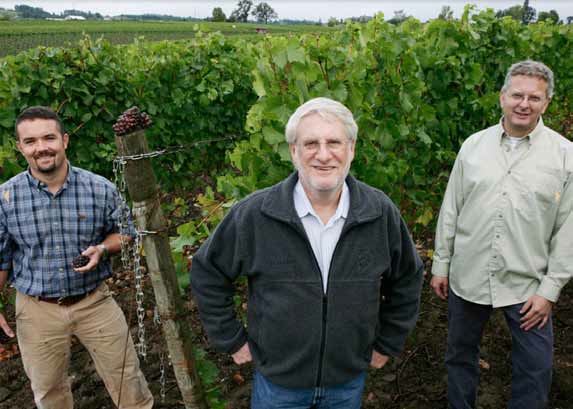 The Adelsheim Vineyard Willamette Valley Pinot Noir blend (so-named since 2004 and often based on Quarter Mile Lane fruit), and Pinot Gris are the workhorses of the winery. Elizabeth’s Reserve Pinot Noir, named for the Adelsheim’s daughter, Elizabeth, and sporting a label drawing of Elizabeth by Ginny, has consisted almost exclusively of Chehalem Mountains fruit since 2000. The vineyard-designated Pinot Noirs (eight in the 2011 vintage) and a “Best of Vintage” Pinot Noir (inaugurated in 2001 with the release of “Vintage 29”) are the prestige bottlings. Since the fall of 2011, the Adelsheim Vineyard Pinot Noirs have had new labels. David notes, “We came to realize that our previous labels did a good job of explaining our past, but did not address our aspirations about the kind of company we intend to become in the future.” The winery and wines carry the L.I.V.E. certification and many wines display the OCSW (Oregon Certified Sustainable Wine) logo as well. The winery is located at 16800 NE Calkins Lane in Newberg and the website is www.adelsheim.com. The Willamette Valley and Elizabeth Reserve Pinot Noirs are distributed nationally to nearly all states and internationally. The tasting room is open daily from 11:00-4:00. If you are lucky to catch David at the winery, you will find he has a wealth of knowledge about Oregon’s wine history. Adelsheim Vineyard is reason enough to consider David one of Oregon’s most iconic vintners. However, it his active and often leadership role in practically every important event that has defined Oregon’s fifty-year modern wine history that is unrivaled. I have listed below some of David’s most notable accomplishments.
* Along with David Lett and others, he lobbied county planning committees to protect designated farmland from
residential growth (Senate Bills 100 and 101) and established the Oregon Department of Land Conservation
and Development.
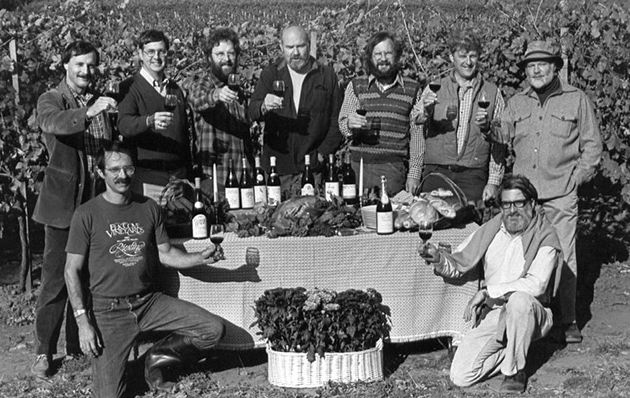
I believe in the tenant, “Behind every great man is a great woman,” and that is certainly apt in the case of David Adelsheim. His spouse, Ginny, worked in the vineyards at Adelsheim Vineyard in the early years, and hosted and cooked for many winery related social events hosted in her home. She also was actively involved in the marketing and distribution of the Adelsheim wines. Perhaps her most important contribution to the winery was the artwork she did for the labels. From 1982 to 2009, Diana Lett’s portrait appeared on the Adelsheim Vineyard Willamette Valley Pinot Noir. The purpose was to give women behind the scenes more recognition in the wine industry. Additional portraits appeared on labels of Ginny’s sisters, close friends, and the Adelsheim’s daughters as a tribute to those who helped establish the winery and brand. Ginny also drew the Adelsheim Vineyard logo and artwork for other Oregon wine events such as ¡Salud! and IPNC. She now works with veterans at a local Veteran’s Administration hospital, instructing them in art and sculpturing. For more information on David and Ginny Adelsheim: Oregon Wine History Project™: www.digitalcommons.linfield.edu. (includes audio and video interviews with David Adelsheim) Adelsheim Vineyard website: www.adelsheim.com. (an excellent website which includes a timeline of the history of the Oregon wine industry and Adelsheim Vineyard, and succinct information on the major Pinot Noir clones) I wish to also acknowledge the following sources of ancillary information used in the preparation of this article: Pacific Pinot Noir (2008), John Winthrop Haeger The Boys Up North (1997), Paul Pintarich
I recently enjoyed the opportunity to taste through the 2011 vintage of Adelsheim Vineyard Pinot Noirs. The wines display several outstanding qualities. Alcohols are unobtrusive, oak is deftly integrated, acidities are bright and refreshing, and tannins are mild and respective, adding up to impressively balanced wines that are approachable now, but in the case of the single vineyard wines in particular, capable of aging for ten or more years. The cool growing season in 2011 produced wines that are relatively light in weight compared to say the 2009 vintage in Oregon, but the wines should put on more weight over time in the bottle, much like the wines did from Oregon’s 2007 vintage. Adelsheim Vineyard Pinot Noirs can be considered exemplary reference standards for the “Oregon style.” David Paige’s winemaking regimen for Pinot Noir is as follows. He prefers to pick at modest Brix. The grapes are de-stemmed into open top fermenters, cold soaked for 4 to 6 days, and fermentation is initiated by inoculation. Malolactic fermentation is both natural and inoculated. The wines are aged at least 10 months in 25% new French oak barrels using several cooperages. The wines are all filtered, and fined on a case-by-case basis. The 2011 Pinot Noirs have been in bottle over a year when tasted.
2011 Adelsheim Willamette Valley Pinot Noir 13.0% alc., pH 3.56, 16,566 cases, $32. 33rd vintage of this wine. 76% of grapes sourced from Adelsheim estate vineyards with the largest percentage from the Chehalem Mountains. The remaining 27% were derived from fourteen other non estate vineyards throughout the Willamette Valley. Aged 10 months in 20% new French oak barrels. · Moderately light reddish-purple color in the glass. Aromas of cherry, raspberry, cut flowers, resinous pine and cinnamon oak. Light in weight with brisk acidity, featuring tart red cherry and cranberry flavors with oak in the background. A forward drinking wine for the weekday dinner table. Score: 86
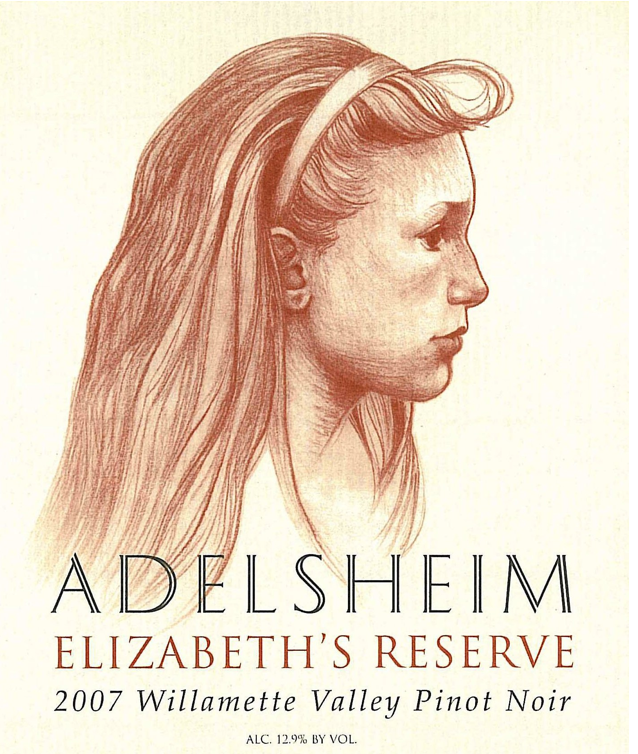 2011 Adelsheim Elizabeth’s Reserve Willamette Valley Pinot Noir 13.0% alc., pH 3.52, 1,306 cases, $55. A best of winery reserve, first bottled in 1986. 72% of the fruit comes from five of the Adelsheim estate vineyards located in the Chehalem Mountains and Ribbon Ridge. · Moderately light reddish-purple hue in the glass. Nicely perfumed with bright aromas of fresh cherry pie glaze, rose petals, spice and oak. A cherry bombast with sneaky intensity, featuring bright, clean flavors, suave tannins and a lively acid underpinning. Easy to like now with it’s ample finish, this wine should benefit from cellaring. Score: 89
2011 Adelsheim Boulder Bluff Vineyard Chehalem Mountains Pinot Noir 13.0% alc., pH 3.45, 372 cases, $68. Lynn and Jack Loacker, co-owners of Adelsheim Vineyard, bought this 9.91-acre vineyard in 2000. Soils are basaltic-origin (volcanic) clay loam. Basalt boulders give the vineyard its name. Three clones were used in this bottling: QM-1 (from Charles Coury in 1974), “828” or AS-2, and Dijon 777. Aged 10 months in 28% new French oak barrels. · Moderately light reddish-purple color in the glass. Appealing aromas of cherry, raspberry and a hint of spice. The relatively light core of red cherry fruit shows good impact on entry and some finishing power. The mouthwatering acidity, balanced tannins and complimentary oak add to the pleasure. Tasted the following day from a previously opened and re-corked bottle, the wine had become more aromatic featuring hi-tone cherry and baking spice aromas. The acidity became quite apparent, ending with a steely, mineral-driven finish. Score: 90
2011 Adelsheim Bryan Creek Vineyard Chehalem Mountains Pinot Noir 13.0% alc., pH 3.53, 375 cases, $75. 19.2-acre vineyard planted to UCD 5, 113, 114, 115 in basaltic-origin (volcanic) clay loam soils. Relatively high in elevation and one of the estate vineyards to be harvested. Aged in 27% new French oak barrels. · Moderately light reddish-purple hue in the glass. Demure, but appealing aromas of cherries, tea and rose petals. Relatively light in weight, but very flavorful, offering juicy flavors of red cherries and berries wrapped in soft tannins. Very polished with a refreshing vein of acidity and soprano finish. Score: 91
2011 Adelsheim Calkins Lane Vineyard Chehalem Mountains Pinot Noir 13.0% alc., pH 3.50, 405 cases, $68. This site was formerly a hazelnut and walnut orchard named after a family that settled the area in the 1890s and lived there into the 1960s. Pinot Noir first planted here in 1996 and the first single vineyard Pinot Noir from the property came in the 2001 vintage. Clones are 115, 667 and 777 planted in marine sedimentary soils. Warmest, lowest elevation and earliest to harvest of the estate vineyards. Aged 10 months in 34% new French oak barrels. · Moderately light reddish-purple color in the glass. Well-endowed with bright aromas of black cherries, cassis and iron. Enticing middleweight flavors of black cherry, pomegranate, cola and subtle oak, balanced by ripe, firm tannins. Very polished and nicely balanced, finishing with a refreshing burst of citrus-infused fruit. Score: 91
 2011 Adelsheim Quarter Mile Lane Vineyard Chehalem Mountains Pinot Noir 13.0% alc., pH 3.52, 82 cases, $105. First planted in 1972, this vineyard is the oldest Adelsheim estate vineyard and is named for the road that forms the northern boundary of the property. This wine comes from a 2.4-acre Block 1 planted in 1974 with what is apparently Martini clone or a mix of Martini and Pommard clones. Basaltic-origin (volcanic) clay-loam soils. Aged 10 months in 33% new French oak barrels. · Moderately light reddish-purple color in the glass. Plenty of energy in the hi-tone aromas of cherries, baking spice and oak. Very classy on the palate with satisfying roundness and a velvety mouth feel. Flavors of red cherries and berries are accented with a noticeable but not obtrusive oak sheen. The juicy, vivid finish is exceptional. Still appealing the following day from a previously opened and recorked bottle with soft, generous red fruit flavors. Score: 93
2011 Adelsheim Ribbon Springs Vineyard Ribbon Ridge Pinot Noir 13.0% alc., pH 3.59, 352 cases, $68. Ninth Ribbon Springs vineyard-designated wine. This 60-acre vineyard has high-density plantings of Pommard (UCD5 and UCD4), Wädenswil (UCD1A), 4407, and Dijon clones 113, 114, 115, 667 and 777 in sandstonebased, sedimentary soils. This wine is composed of UCD 4 and UCD5. Aged 10 months in 29% new French oak barrels. · Medium reddish-purple color in the glass. Distinctive aromas of black fruits, clove, cola and oak spice. Appealing fullness on the mid palate with moderately rich flavors of black cherry and blackberry framed with a hint of spice and anise. Plenty of pizzaz to please with a satiny texture, polished tannins and a palate staining black cherry explosion on the finish. Score: 93
2011 Adelsheim Nicholas Vineyard Chehalem Mountains Pinot Noir 13.0% alc., pH 3.47, 161 cases, $90. This vineyard was first planted by Nick and Sheila Nicholas in 2001 who make their own wines under the Anam Cara label. 100% clone 667 planted in Laurelwood soils (wind-blown ice age sediment) covering basalt. Aged 10 months in 33% new medium-toast French oak barrels. · Moderately light reddish-purple color in the glass. Deep aromas of fresh red cherry tart and spice are echoed on the palate. Husky tannins create a firm mouth feel and a complimentary note of oak adds interest. The peacock tail finish is special. The wine still showed exceptional character and balance the following day from a previously opened and re-corked bottle. Did I mention the finish? Score: 92
2011 Adelsheim Zenith Vineyard Eola-Amity Hills Pinot Noir 13.0% alc., pH 3.52, 143 cases, $90. Third single vineyard wine from this vineyard that was originally planted in the early 1980s by Pat O’Connor. Kari and Tim Ramey bought it in 2002 and renamed it, expanding the plantings to 70 acres. Clones are 667, “828,” 115, and Pommard planted in volcanic and sedimentary soils. Aged 10 months in 31% new medium-toast French oak barrels. · Moderately light reddish-purple color in the glass. Seductive aromatics offering scents of black cherries, forest floor and spice. Soft in the mouth and relatively light in weight, with appealing black cherry flavor set off by an earthy note. The tannins are nicely balanced and the good acidity adds grip. Even better the following day from a previously opened and re-corked bottle with glorious aromatics. Score: 91
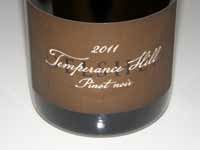 2011 Adelsheim Temperance Hill Vineyard Eola-Amity Hills Pinot Noir 13.0% alc., pH 3.60, 363 cases, $68. 100% clone 667 planted in basaltic-origin (volcanic) soils. This 100-acre vineyard was established by Edward and L.S. Koo in 1981. Adelsheim replanted on of the ideal sections of the vineyard. A late ripening site. Fifth single vineyard bottling. Aged 10 months in 33% new medium toast French oak barrels. · Medium reddish-purple color in the glass. The nose is striking with bright aromas of Bing cherries, raspberries, and spice. Outstanding depth and length of flavor featuring a core of dark red cherries and berries with a hint of graham, cola and spice. Seductively ethereal in the mouth, with firm, supportive tannins, and a long, long, long finish. A brilliant wine with superb balance. Still extraordinary when tasted the following day from a previously opened and re-corked bottle. Score: 94
Hanzell Vineyards: Latest Chardonnay Releases Including the Introduction of De Brye Vineyard ChardonnayCountess Barbara de Brye purchased the Hanzell Vineyards estate in 1975 as a business investment and the family’s vacation retreat. Her son, Alexander, visited the Hanzell estate for the first time at age five months and spent his youthful years exploring every oak tree and vineyard path on the property. At sixteen years of age, he inherited the Hanzell estate, shouldering the care, maintenance and business management of a wine icon that has been revered since its founding in 1953. In 1998, Alexander assumed the helm of Hanzell Vineyards, and along with an International Board of Directors and winemaker Bob Sessions, created and implemented a fifteen year plan to sustain and protect the future of Hanzell Vineyards. Alexander developed a design to slowly grow Hanzell to 46 acres of vineyards and slowly increase production from 3,000 to 8,000 cases. Dr. Paul Skinner of Terra Space was hired to direct a vineyard replant to improve under performing vineyard blocks, adding to not only St. George rootstock but other new rootstock selections. The work in the existing vineyards continues today. New vineyards were planted between 1999 and 2008, and a new barrel aging cave and winery building were completed in 2004.
 The 16-acre de Brye Vineyard was first planted in 1976 by Bob Sessions and José Ramos Esquivel in a field dotted with grand oaks and an expansive view of San Pablo Bay, Mount Tamalpais and San Francisco. This vineyard, now in its 37th year, could be considered the heart of the estate since it has supplied the power behind Hanzell’s Estate Chardonnay since the mid-1980s. Consisting of 15 acres (13 acres planted originally and two more acres added in 1999), the de Brye Vineyard is located close to the top of the property with a southern exposure and a 10% slope to its terraced vine rows. It is planted with Hanzell clone Chardonnay and Pinot Noir budwood propagated from the Ambassador’s 1953 Vineyard on St. George rootstock. The soils are Red Hill Series clay loam, which is moderately well drained and underlain with a mix of basaltic rock, and typically found on ridgetops and mountainous uplands. A photo of the de Brye Vineyard and a schematic of the Hanzell vineyards is included below. The de Brye legacy has expanded with the introduction of the first single vineyard selection bottling from the de Brye Vineyard, the second release as part of a series of new Estate Single Vineyard wines introduced for the first time this year. The first wine, the Sessions Vineyard Pinot Noir, was introduced in March 2013 and was discussed and reviewed in the PinotFile, Volume 9, Issue 17 at www.princeofpinot.com/article/1390/.
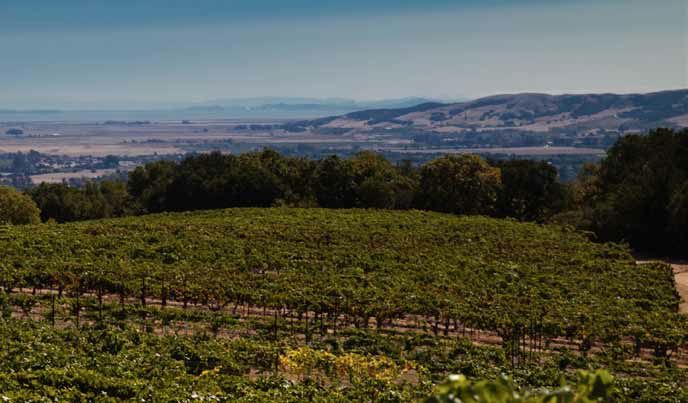
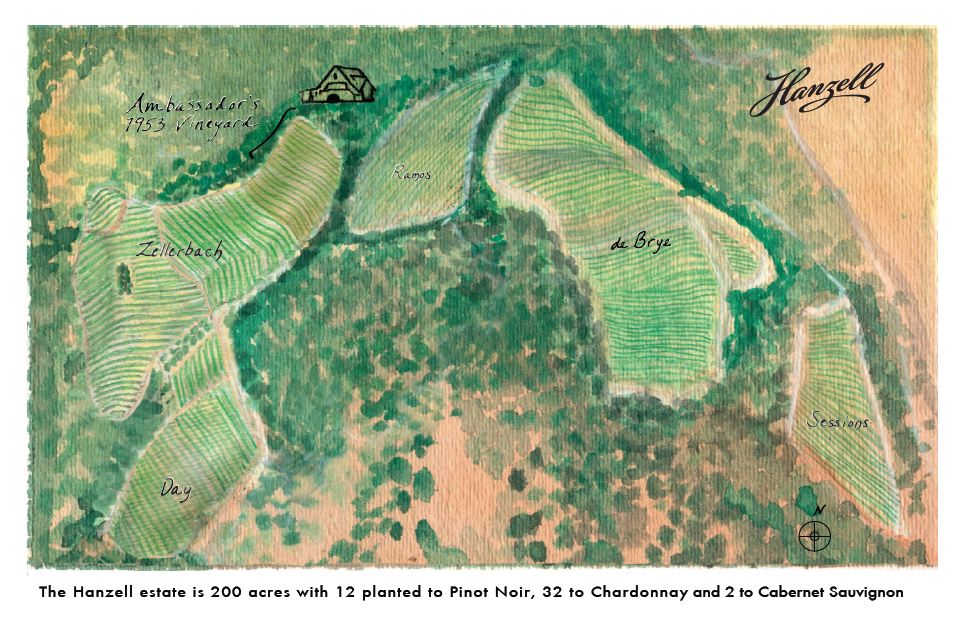 2011 was a challenging vintage in the Sonoma Valley. Rain and cold weather during bloom caused a considerable amount of shatter (millerandage). Chardonnay yields were down on the Hanzell estate by 40% with some blocks down as much as 50%. Because of the extra ground moisture from the rain coupled with the low crop load, the vines produced additional shoots and leaves requiring extra suckering, leaf pulling and hedging passes to keep the canopy in balance with the light crop. Harvest began on September 20 after one of the coolest growing seasons on record. According to winemaker Michael McNeill, traditional Hanzell practices of limited skin contact, carefully controlled fermentations, and a moderate use of new French oak were employed. Through a rigorous evaluation of barrel lots and then the blending process, only six barrels of de Brye Chardonnay were selected to be bottled as the inaugural de Brye Vineyard Chardonnay. Despite the vintage vagaries, McNeill said, “The de Brye Chardonnay expresses the qualities and age-worthy style of this unique estate.” The Hanzell Estate Chardonnay also underwent a rigorous evaluation and blending process such that only select barrels were included in the final blend. The 2012 vintage offered an ideal spring with warm sunny days interspersed with well-timed rains. Set resulted in dense, full clusters. The summer was noteworthy in that it lacked the typical heat waves. Still, several thinning passes were required to maintain the balanced low yields that are preferred. Harvest began for the Hanzell “Sebella” Chardonnay on August 27 in the Zellerback Vineyard with the Robert Young and Old Wente clones, and concluded on September 11 with the Hanzell clone from the Ramos Vineyard.
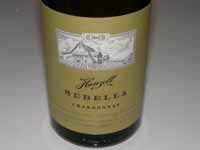 2012 Hanzell “Sebella” Sonoma Valley Chardonnay 13.5% alc., pH 3.20, TA 0.72, 3,564 cases, $36. Sourced from younger estate vines. Bottled April 2-10, 2013. 100% stainless steel fermented with no malolactic fermentation. Finished and aged for 3 to 6 months in 1 to 4-year-old French oak barrels. · Light golden yellow color and clear in the glass. An array of aromas leap out of the glass, including white peach, lemon zest, fresh cut apple, and a hint of just-baked croissant. The nose never wavers over a one hour period in the glass. Fruit is front and center with flavors of white grapefruit, green apple and lemon. Slightly steely, yet soft and smooth, ending with a good snap of acidity. Very satisfying and friendly for early drinking. Score: 90
2011 Hanzell Sonoma Valley Chardonnay 14.5% alc., pH 3.30, TA 0.68, 1,782 cases, $75. Bottled April 22-25, 2013. Heritage clones, rigorous pruning. Aged 18 months total with 12 months in 33% new French oak barrels. · Moderately light golden yellow color and clear in the glass. Lovely aromas of lemon curd, honey, buttery brioche, hazelnut and ocean breeze. Attention-grabbing intensity on the mid palate with energetic flavors of lemon, apple and spice, finishing with power, focus and razor sharp, palate cleansing acidity. The wine offers impressive harmony that bodes well for longevity. Score: 93
 2011 Hanzell de Brye Vineyard Sonoma Valley Chardonnay 14.5% alc., pH 3.30, TA 0.69, 152 cases, $78. Bottled April 25, 2013. Inaugural release. From a vineyard planted in 1976. St. George rootstock and Hanzell clone selection massale from the original Ambassador’s 1953 Vineyard. Aged 18 months total with 12 months in 33% new French oak barrels. · Moderate golden yellow color and clear in the glass. Reserved, but complex nose, offering aromas of lemon, grilled pineapple, baked apple and hazelnut. Very creamy and harmonious on the palate with the lemon and apple fruits draping the structure such that the wine feels sleek. More body and fullness than the estate bottling with added power on the finish. Remarkably silky on the finish as well, literally slipping off the back of the palate. Still superb when tasted from a previously opened and re-corked bottle two days later. This wine is still young and will benefit from a few years of cellaring to reach its apogee. Score: 94
Hanzell wines are available for purchase by guests visiting the new Hanzell Vineyard’s website at www.hanzell.com. The Collector Program guarantees an allocation of Hanzell Vineyards Estate Pinot Noir and Chardonnay and the Ambassador’s Circle Exclusive and Private Collector levels provide access to the Ambassador’s 1953 Vineyard releases, the Hanzell wine library annual offering and the holiday magnum offering. Future Estate Single Vineyard wines include a 2011 Ambassador’s 1953 Vineyard Chardonnay and single vineyard wines from Ramos Vineyard and Day Vineyard. Visitors are received by appointment only. Two levels of visits are offered, both of which include a guided vineyard tour and seated tastings. The winery should be on every pinotphile’s bucket list of iconic wineries to visit.
Hanzell Vineyards First Restaurant Account: Reminiscing the Imperial DynastyHanford, California is a relatively small San Joaquin Valley town that became a destination for gourmands seeking the Chinoise cuisine (a fusion of Chinese and French cooking) of third-generation Californian Richard C. Wing at his Imperial Dynasty restaurant. For nearly fifty years, a long list of celebrity diners including Walt Disney and Bing Crosby flew to Hanford just to eat there. A cadre of New York attorneys flew to the restaurant four times a year. Many groups traveled frequently from the Bay Area, Fresno and Southern California by car or train in a gastronomic pilgrimage to this creative restaurant. I loved dining there so much that I made the four-hour drive with friends from my home in Orange County to eat there at least three times a year over a twenty year span.
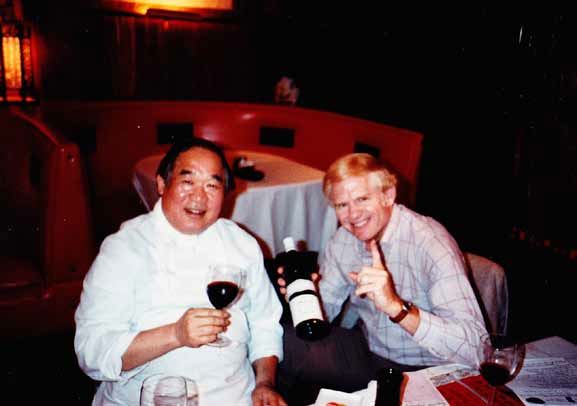 Perhaps even more implausible than the exalted culinary tradition established by Richard in Hanford’s China Alley, California’s first Chinatown, is the fact that the restaurant had a distinguished wine cellar housed in a former opium den that held some 60,000 bottles and a Wine Spectator Grand Award winning 1,100 entry wine list. Richard’s brother, Ernie, was instrumental in establishing the early reputation of the Imperial Dynasty wine cellar. As a knowledgeable wine buff, Ernie introduced the restaurant’s wine list in 1957, and soon filled the Imperial Dynasty wine cellar with collectible California wines from Beaulieu, Charles Krug, David Bruce, Freemark Abbey and Heitz Cellars, and French wines from Domaine de la Romanee-Conti, Petrus, Lafite, Mouton, Latour and Haut-Brion. When possible, Ernie would typically age the restaurant’s wines for four or five years before putting them on the wine list so they could be enjoyed at or closer to their peak. Although Ernie died at a relatively young age in 1972, Richard maintained the extensive wine cellar. He tasted wine regularly, and the proper marriage of food and wine became his passion. Richard knew wine and how to match wine with his cuisine, but like many of his varied talents, he always downplayed his expertise. The Imperial Dynasty was the first restaurant account for both Hanzell Vineyards and Stony Hill wineries, and one of the first restaurant accounts for several other iconic Napa Valley wineries including Heitz Cellars and Caymus. Although the restaurant had a “regular” menu of ala carte Continental and Chinese specialties, out-of-town diners opted for the gourmet prix fixe menu arranged by advanced reservation. The gourmet menu consisted of six courses, accompanied by appropriate wines for each course suggested by Richard. The menu was hand written by Richard for every table each night. A copy of a gourmet menu from dinners I attended in 1986 that included Hanzell Chardonnay and 1992 featuring Hanzell Pinot Noir are reproduced below.
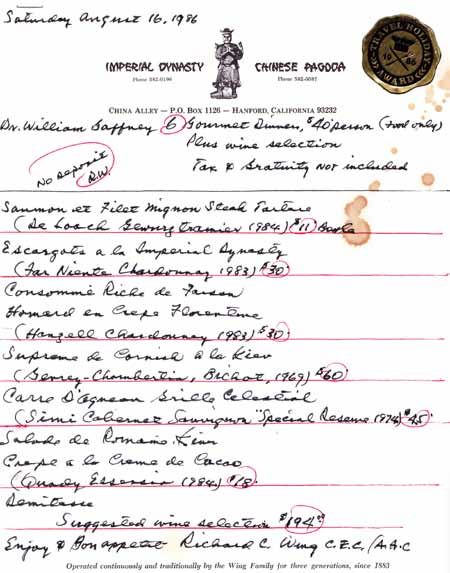
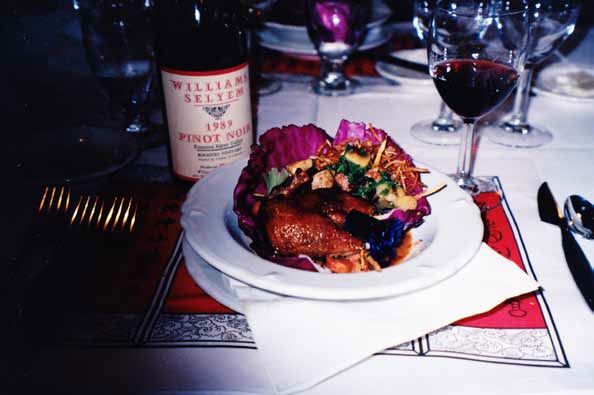
 A tour of the wine cellar always preceded dinner, where diners could search out gems to accompany their dinner or augment Richard’s selections. Prices for wine and food were extremely reasonable by usual restaurant standards of the time. Richard had a captivating sense of humor, and as a joke, he penned a menu for me in 1994, with a note that my good friend, Alain Wu, would pay for the wine selection. We never partook of this menu and wine selection, but it shows that Richard knew of great wines.
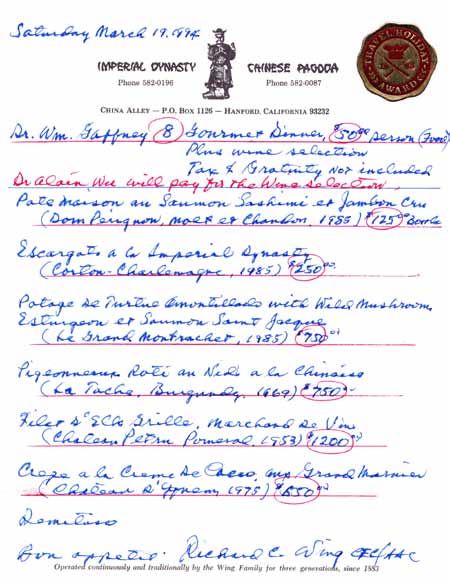 Sadly, the Imperial Dynasty was never sold upon Richard’s retirement, perhaps because his was an impossible act to follow. Finally, after manning the stove at the Imperial Dynasty for almost fifty years, Richard retired at 85 years of age and the restaurant was shuttered. Richard passed away at 89 years of age in 2010. I have often reflected on the many times I spent at the table with him, touched by his unwavering devotion to his profession and his ebullient personality. He called himself a “humble Chinese chef,” but he was highly venerated by his family and a cadre of culinary devotees alike. The photo below shows me in my younger days with my lovely wife, Patti, who patiently endured the many bacchanalia's we attended at the Imperial Dynasty.
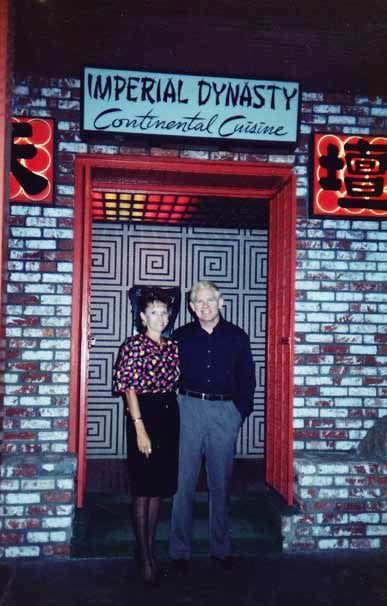 For further reading: Noodles through Escargots, Arlanne Wing and Steve Banister, 2011.
Small Sips of Recently Tasted Pinot Noir
2011 C. Donatiello Winery Russian River Valley Pinot Noir 13.4% alc., pH 3.56, TA 0.63, 513 cases, $40. Sourced from multiple vineyard sites throughout the appellation. Aged 10 months in 25% new French oak barrels. · Moderate reddish-purple color in the glass. Oak overwhelms the fruit in this wine which is light and crisp on the palate, featuring red cherry and raspberry fruit flavors with a citrus-imbued finish. Score: 85
2011 C. Donatiello Winery Hervey Vineyard Russian River Valley Pinot Noir 13.2% alc., 101 cases, $60. The 10-acre Hervey Vineyard is located above Atascadero Creek in the hills just south of Sebastopol. Soils are Goldridge. Aged 10 months in 25% new French oak barrels. · Moderately dark reddish-purple color in the glass. The nose has some reduction upon opening which disappears by the following day when re-tasted from a previously opened bottle. Ripe black cherry aromas accented by charred, smoky oak. Deep Bing cherry and cola flavor with a firm, but balanced tannic backbone. The wine is underlain with crisp acidity producing a tangy, citrus-driven finale. This wine warrants more time in bottle to better integrate the oak. Score: 87
2011 C. Donatiello Winery Tina Marie Vineyard Russian River Valley Pinot Noir 13.7% alc., pH 3.44, TA 0.62, 126 cases, $55. Aged 10 months in 35% new French oak barrels. · Moderately dark reddish-purple color in the glass. The nose offers enticing aromas of black cherry, rose petals, tea, forest floor and cedary oak. The tasty essence of fresh Bing cherries has a hint of spice and conifer in the background. The tannins are supple and the wine sports a citrus-infused, sweet cherry finish. Score: 88
2011 C. Donatiello Winery Riddle Vineyard Russian River Valley Pinot Noir 13.9% alc., 52 cases, $N/A, sold out. Aged 10 months in 40% new French oak barrels. · Medium reddish-purple color in the glass. A bright wine with a spring in its step. Aromas and flavors of dark Bing cherry and raspberry with smooth, supportive tannins and a good cut of acidity. Seamless and easy to like. Tasted the following day from a previously opened and re-corked bottle, the black cherry fruit had drifted to the ripe side. Score: 89
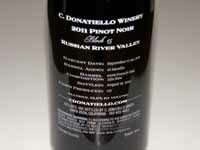 2011 C. Donatiello Winery Block 15 Russian River Valley Pinot Noir 13.6% alc., pH 3.45, TA 0.68, 127 cases, $48. A blend of vineyards featuring clone 777. Aged 10 months in 25% new French oak barrels. · Moderate reddish-purple color in the glass. The nose hits all the high notes with effusive aromas of dark cherries and complimentary seasoned oak. Delicious essence of Bing cherries with a hint of spice and red licorice flavors. The mid palate richness carries through to the sleek, long finish. The wine is beautifully composed with supple tannins and good acidity. Thoroughly satisfying with easy accessibility and my clear favorite of the C. Donatiello Pinot Noirs in 2011. Score: 91
Note: Chris Donatiello originally founded his namesake label with partner Bill Hambrecht in 2008 on Westside Road at the site of the former Belvedere Winery. The wines were quite good, but the classy operation ceased operation at this site and has been reincarnated, still in Healdsburg, with the original winemaker, Webster Marquez who worked at Williams Selyem and is one of a trio of winemakers at Anthill Farms. A tasting room has opened on the plaza on Center Street in downtown Healdsburg.
2011 Carmel Road Panorama Vineyard Arroyo Seco Monterey County Pinot Noir 15.0% alc., pH 3.75, TA 0.55, $35. Inaugural vintage. From an estate vineyard that is planted to high density and certified sustainable. Primarily clones 667 and 777 with added 2A and 23. Aged 15 months in 25% new French oak barrels. · Dark reddish-purple color in the glass. Aromas of blackberry jam, cardamom spice, forest floor and oak vanillin. Big, ripe and full-bodied with a luscious core of boysenberry, blackberry, black plum, spice, dark chocolate and oak flavors. The high alcohol contributes to the creamy mouth feel. The finish is driven by sappy fruit flavors with a bit of oak and heat lingering on the finish. Score: 87
2011 Gary Farrell Hallberg Vineyard Dijon Clones Russian River Valley Pinot Noir 14.4% alc., pH 3.45, TA 0.57, 400 cases, $60. Released May 2013. 100% de-stemmed, 5-day cold soak in small, open-top tanks. Aged 8 months in 40% new French oak barrels. · Medium reddish-purple color in the glass. Aromas of black cherries, baking spice, dried rose petals and new oak lead to middleweight, perfectly ripened flavors of dark cherries, black raspberries and oak spice. A spot of cola, sassafras and mushroom earthiness adds interest. Smooth on the palate with supportive tannins and welcoming accessibility. Score: 88
 2011 Gary Farrell Hallberg Vineyard Clone 777 7% Whole Cluster Russian River Valley Pinot Noir 14.3% alc., pH 3.52, TA 0.60, 260 cases, $65. Released September 2013. One of a new series of wines called the (Winemaker’s) Inspiration Series for limited release. Inaugural bottling. From Block C at the Hallberg Vineyard, one of the coolest parts of the vineyard planted to clone 777. Aged 13 months in 40% new French oak barrels. · Medium reddish-purple color in the glass. The nose offers the essence of black cherries with accents of cardamom spice, dark red rose petals and oak vanillin. Delicious core of fresh black cherry and red raspberry fruits with a hint of exotic spice, savory herbs and cedary oak. The wine is soft and smooth on the palate with pleasing finesse, and finishes with a well-endowed cherry-driven finish. Score: 91
2011 Twomey Bien Nacido Vineyard Santa Maria Valley Pinot Noir 12.9% alc., pH 3.48, TA 0.58, $54. Released September 14, 2013. From organically farmed hillside plantings including Block N, one of the original 1972 plantings of the Martini clone on its own roots. Aged 13 months sur lie in 58% new and 42% once-used French oak barrels. · Moderately light reddish-purple color in the glass. A number of aromas jump out of the glass, including black cherry, black currant, baking spice and toasty oak. Sleek and satiny on the palate, with flavors of red cherries, raspberries, pomegranates, cola and vanilla. The modest fruit concentration is buoyed by gossamer tannins and juicy acidity. Score: 89
Pinot BriefsPortland Monthly Oregon’s 50 Best Wines 2013 “Sure-bet splurges” included 2011 Bethel Heights Casteel Reserve Eola-Amity Hills Pinot Noir ($60) and 2011 Antica Terra Botanica Willamette Valley Pinot Noir ($75). “Prized Pinots” included 2010 Soter Mineral Springs Ranch Yamhill-Carlton Pinot Noir ($50), 2010 Colene Clemens Vineyards Reserve Chehalem Mountains Pinot Noir ($45), 2011 Cristom Vineyards Mt. Jefferson Willamette Valley Pinot Noir ($30), 2011 Ayres Vineyards & Winery Willamette Valley Pinot Noir ($25), 2011 Cameron Winery Dundee Hills Pinot Noir ($26), 2011 Love & Squalor Willamette Valley Pinot Noir ($24), 2011 Crowley Wines Willamette Valley Pinot Noir ($24), 2010 The Eyrie Vineyards Estate Dundee Hills Pinot Noir ($35), 2011 Patricia Green Cellars Estate Vineyard Ribbon Ridge Pinot Noir ($30), and 2011 Vincent Wine Co Ribbon Ridge Pinot Noir ($24). Restoration of Hoffman Mountain Ranch The Hoffman Mountain Ranch (HMR) and Winery was developed by Dr. Stanley Hoffman in the early 1970s at an elevation of 2,200 feet in the Adelaida District AVA in the western hills of Paso Robles. The 1,200-acre site was originally planted under the guidance and direction of Andre Tchelistcheff in 1964. HMR began producing HMR wines, including Pinot Noir, in 1972, with Tchelistcheff as a winemaking consultant. The original HMR winery is considered the first modern commercial winery in Paso Robles. The historic HMR property has been purchased and renovated by Georges and Daniel Daou of DAOU Vineyards and Winery. The Daou brothers founded DAOU Winery 8 years ago, planting their mountain property with mostly Bordeaux grape varieties. In 2012, they purchased the remaining 112 acres of Hoffman Mountain Ranch, and began restoring the half century old redwood winery. The historic cellar is being used for the 2013 harvest. A ribbon cutting ceremony will be held October 20 with special guests Dr. and Mrs. Stanley Hoffman and Dorothy Tchelistcheff. Anderson Valley Trade Tasting in San Francisco On Tuesday, November 12, the Anderson Valley Winegrowers Association (AVWA) is organizing a tasting of wines from 25 to 30 Anderson Valley wineries at Fort Mason Center, with food pairings by local restaurants and purveyors. Other upcoming AVWA events include the Ninth Annual International Alsace Varietals Festival (February 8-9, 2014), the Seventeenth Annual Anderson Valley Pinot Noir Festival (May 16-18, 2014) and the Anderson Valley Barrel Tasting Weekend (July 26-27, 2014). For information visit www.avwines.com or contact Kristy Charles at Kristy@foursightwines.com. Santa Barbara County Vintners’ Association Celebration of Harvest Festival This annual weekend event, held October 11-14, 2013, will feature the signature Celebration of Harvest Festival on Saturday, October 12, featuring more than 100 winery members of the Santa Barbara County Vintner’s Association pouring at the Rancho Sisquoc Winery (tickets are $85). For details about the event, check www.sbcountywines.com. Visit the Santa Ynez Valley Hotel Association website at www.syvha.com for partnering accommodations.
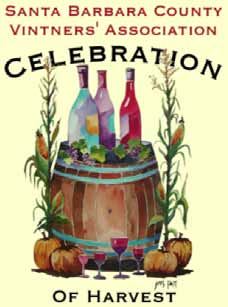 Maison Louis Jadot Acquires Resonance Vineyard in Oregon Jacques Lardiere, the vigneron for Maison Louis Jadot for forty years who retired in 2012, apparently is enamored enough with the potential of Oregon Pinot Noir to leave retirement to craft wine from the 32-acre Resonance Vineyard. He has moved to the Yamhill Valley to direct the farming of the vineyard and winemaking program which will take place at Trisaetum Winery. Initially, the focus will only be on estate Pinot Noir. The vineyard, located in the Yamhill- Carlton was owned by Kevin and Carla Chambers whose family have farmed in Oregon for five generations, and was originally planted in 1981. The Pinot Noirs from this vineyard have been consistently superb and I have highly rated examples from Sineann Winery and Big Table Farm. This will be the first foray for Jadot in the New World, but probably not the last as it has become too costly to expand in Burgundy. Read more in “Welcoming Jadot,” in the Oregon Wine Press, October 2013. In The Drinks Business (October 7, 2013), the president of Maison Louis Jadot, Pierre-Henri Gagey, outlined his aims for the company’s Oregon project. He said, “We are not trying to reproduce Burgundy in Oregon - we are searching for purity and truth. If we can do that then we can be successful.” Soliste Continues Innovative String of Wines The latest release from Soliste, the 2011 St. Andelain Lake County Sauvignon Blanc, is a homage to the incomparable, late Didier Dagueneau, the “Master of St. Andelain.” Dagueneau single handedly revolutionized Sauvignon Blanc, bringing it to up the status of any Grand Cru white Burgundy. Known for his wild mane of unkempt hair and bushy beard, he was an iconoclast among vignerons and sommeliers. Though he had no formal winemaking training, he was infatuated with great Burgundies and used methods uncommon to Pouilly-Fumé, including severe pruning for drastically low yields, hand-harvesting of fruit over several successive passes through the vineyards, vineyard-designate bottlings, skin contact, and barrel fermentation. He also created his own barrels, the most famous being a cigar shape barrel. Dagueneau’s wines became the unchallenged leaders of Pouilly-Fumé, including Pur Sang, Silex, Buisson Renard and Asteroide. Soliste aim is keep the dream alive with their latest release from a single organic vineyard in Lake County, California, an area known for Sauvignon Blanc excellence. The grapes were destemmed and allowed 36 hours of skin contact to create unique richness and depth. After pressing, the wine was barrel fermented and aged for 16 months in Didier’s creation, the cigar barrel. There was no malolactic fermentation to preserve acidity, verve and length. Aldo Sohm, the Chief Sommelier at New York’s Le Bernardin restaurant, said, “This is the best white wine I have ever tasted, period, anyplace, anytime.” I can’t argue with that statement, having recently tasted the wine myself. Only 223 cases produced, $55, sold by allocation to preferred list customers at www.soliste.com. Soliste wines are also available at many of the finest restaurants in major metropolitan areas in the United States.
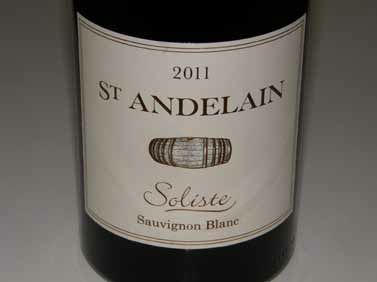 Oregon Wine Industry Booming According to the Oregon Wine Board, the Oregon wine industry has an economic affect of nearly $3 billion annually. The amount of vineyard acreage and number of wineries has increased markedly each year since 2001 with 850 wineries now in production sourcing from more than 20,000 acres of vines. The American Wine Consumer Coalition in August gave Oregon the top ranking as the most friendly to wine consumers. Wine Catches Beer in Popularity As reported in the Wine Spectator, October 31, 2013, a Gallup poll in early July found that wine and beer were in a statistical tie as far as popularity among alcohol-consuming participants in the poll. The Gallup poll reported, “U.S. drinkers‘ preferences have shifted to the point that drinkers are now just as likely to say they drink wine most often as to say beer.” The Beverage Information Group 2012 Wine Handbook latest figures support the continued strength of U.S. wine consumption which increased for the 19th straight year. The wine industry grew 1.9 percent in 2012 to reach 318.0 million 9-liter cases. The most popular wines that drove the increase were un-oaked Chardonnay, Rosé, sweet wines, sparkling wines and red blends. Total wine sales in 2012 were $28.9 billion. DTC sales continue to grow, now contributing $1.4 billion to the industry. Latest Screw Cap Statistics Wine Spectator (April 30, 2013) reported the following percentage of wines bottled under screw caps: New Zealand 91%, Australia 70%, Oregon 25%, Argentina 15%, Washington 12%, California 8%, Spain 7%, France 3% and Italy 2%. Josh Jensen Recognized in Wine Spectator In the October 15, 2013, issue of the Wine Spectator, James Laube pens a memorable tribute to Josh Jensen, the founder of Calera Wine Company. Titled, “Pinot Pioneer: Josh Jensen Made His Dreams of Burgundy Come True in California,” a few interesting facts came out of the article. The first property he bought in San Benito County in 1975 consisted of 320 acres and was priced at $18,000 and his second 320-acre property, purchased in 1982, cost $150,000, presumably because it had a water source. His first wine was a Zinfandel produced from purchased grapes. His first Pinot Noirs, from Jensen, Reed and Selleck vineyards, one barrel each, were made in 1978 and bottled in 375 ml format. All Pinots except de Villiers Vineyard are 100% whole cluster. Jacques Seyesses of Domaine Dujac in Burgundy noted in the article, “To me they (Calera wines) are the most Burgundian of California Pinots, and the ones that I have tasted that really age well.” I too find the wines are often relatively unapproachable when young, much like top red Burgundies, but blossom beautifully over time in the cellar.
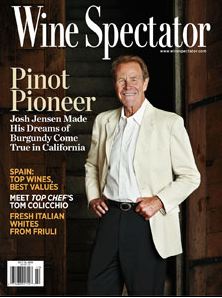 Orange Coast Magazine Wine Dudes Blog I have been writing a blog along with Eric Anderson, the other “Wine Dude.” Check out my recent posts on “Wine Label Lingo,” “Free Wine Search Websites,” and “Grape Radio,” at www.orangecoast.com/winedudes. I feature “Must-Try Wines of the Week” as well, which are most often a North American Pinot Noir or Chardonnay.
Early Peek at 2013 Pinot Noir HarvestAdam Lee, proprietor and winemaker of Siduri Wines (www.siduri.com), travels the states of California and Oregon sourcing grapes from multiple wine regions for his excellent appellation-designated and vineyarddesignated Pinot Noirs. I don’t know of another Pinot Noir winemaker who tackles such a formidable task, so I look to him when I want an overall view of a vintage. When I spoke with Adam on October 8, harvest was winding down.
“First off, the 2013 vintage was early. People usually associate early with hot, but the growing season was not particularly hot. It wasn’t cold like 2011 or even 2010, rather normal to slightly warmer. The vines budded out early, set early and harvested early. We picked in August for the first time ever as a winery.” “The crops were big. They may not be quite as big as 2012 (I haven’t calculated it yet), but it is close. Some vineyards threw a big crop, but a few did not, so that is probably what swung the vintage to being overall slightly smaller. Sta. Rita Hills was bigger in 2013 than 2012, Santa Lucia Highlands was slightly bigger, and Russian River Valley and Sonoma Coast were more variable with some sites bigger than others.” “Sugars were somewhat all over the place. It wasn’t a tremendously big year as far as Brix goes, and it didn’t strike me as a year where you always needed high Brix to have good ripeness. We picked at 20º Brix and at 28º Brix. I think the larger crops kept Brix accumulation in check.” “Interestingly, there always seemed to be something out of whack with the juice numbers. In many cases, it was the malic acid numbers which were high. Usually as the grapes ripen, the malic acid goes down as a percentage of total acid and around one-third at harvest, but that did not happen frequently this year. For example, if the juice was brought in at a pH of 3.45 (pretty good), the malic was half or more of the total acid, so you found yourself having to add acid even though the initial pH was pretty good. The YAN (nutrient levels in the must) were very low generally and it is thought that this was due to the drought.” “How are the wines? They are at least very good, maybe better, but I am not certain they are at the level of 2012. Having said that, there are sections that are as good as 2012, so it is possible to make wines as good as last year. We will probably need to be more selective to get there. The challenge in pinning quality on a vintage early is that high malic acid years are notoriously difficult to figure out early. There is a greater shift post malolactic fermentation, and the wines change more. 2013 is not a great year to prognosticate early on wine quality.”
“Oregon experienced a very dry, pretty warm year throughout the growing season. Set was variable, starting early in some areas and later in others. That was even true within the same vineyard, with certain clone and rootstock combinations starting early and others later. In the middle of set it became quite cold so growers talked of two different sets leading to a lot of variability. The sites that set early seemed to have a lot of the peas and pumpkins (hens and chicks, millenderage) while those that started later did not. Overall, the crop was definitely bigger in Oregon in 2013.” “Often there seems to be some weather similarities between California and Oregon and that was true until September. Then when it was warm in California, it was cold and wet in Oregon. Our vineyards in the Chehalem Mountains got almost 7 inches of rain in September. This caused the areas that had millenderage to be most affected, with the tiny seedless berries bursting. That brought in the birds. It also brought in fruit flies, something not seen in such abundance even by old time growers (see vineyardist Andy Humphrey’s statement below). Sections that were ripest were hit hardest by all these factors.” “The sections that set later had a more uniform set and generally bigger berries. These sections didn’t have the split berries, but did end up with some botrytis. Sugars on everything went down, and pH levels went up due to the rain. Nutrient levels were a record low, due largely to a dry summer and un-irrigated vines. The wines will be low in alcohol, but seem to have surprisingly good color thus far.” “There is still a good amount of fruit hanging as the weather has improved.” Robert Parker, Jr., largely declared the vintage over in Oregon as of October 2 when he reported, “2013 Oregon harvest, which held so much promise 3 weeks ago, has largely been devastated by heat and frequent rains and invasive fruit fly species.”
Well-known vineyard manager, Andy Humphrey, provided the following correspondence to his clients on October 7.
• “Even the oldest guy I could find who has been doing this since 1969 has never seen Drosophila in the fruit
like this. There are a couple of even older guys, but they probably don’t remember.
 |